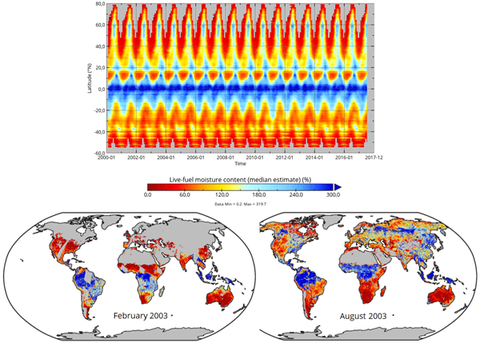03.01.2023
Publikation: Globale Abschätzung des Blattwassergehaltes

Global dynamics of leaf moisture content.
Estimating leaf moisture content at global scale from passive microwave satellite observations of vegetation optical depth
The environmental remote sensing group published a new research article in the Journal Hydrology and Earth System Sciences in which we developed a method to estimate the moisture content of leaves (or live fuel moisture content, LFMC) globally. The method uses observations of Vegetation Optical Depth (VOD) from passive microwave satellite observations and we develop a first global dataset of vegetation leaf moisture content for the period 2000-2017. The paper was led by Matthias Forkel.
Leaf moisture content is defined as the ratio of leaf water mass to leaf dry biomass, or live-fuel moisture content (LFMC). LFMC is important to assess drought and the danger of fire occurrence and spread. LFMC is measured at various sites globally and provided in the Globe-LFMC database (Yebra et al. 2019). We used Vegetation Optical Depth (VOD) from the VODCA dataset (Moesinger et al. 2020) and LFMC from the Globe-LFMC database and from MODIS satellite observations.
VOD and LFMC show widespread positive temporal correlations. Low and partly negative correlations occur in mountain regions. The correlation between LFMC and VOD is highest for LFMC samples from forbs and grasses and lower for trees. However, variability is high and some forest sites also show hight correlations. The short wavelength Ku-band VOD has slightly higher correlations than X or C-band. We developed and tested four different model approaches and a random forest to estimate LFMC from VOD. A logistic regression that uses daily Ku-VOD and monthly Leaf Area Index (model B) reached the best performance (blue dots in Figure). The best-performing model approach was then applied to global VOD data and to LAI to estimate LFMC globally.
The global dataset shows high LFMC in tropics with a very weak seasonality, high seasonality in Savannahs and temperate-boreal regions. A comparison with drought indices shows that the VOD-based LFMC resembles drought events. However, LFMC has a strong seasonality. Long-term year-to-year changes in LFMC are stronger correlated with drought indices than seasonal dynamics.
The new VOD-based LFMC dataset is open available at zenodo:
- spatial coverage: global, 0.25° x 0.25°
- temporal coverage: daily, Feb 2000 - July 2017
- Data download
Publication:
Forkel, M., Schmidt, L., Zotta, R.-M., Dorigo, W., and Yebra, M. (2023).
Estimating leaf moisture content at global scale from passive microwave satellite observations of vegetation optical depth
Hydrology and Earth System Sciences, 27, 39–68, https://doi.org/10.5194/hess-27-39-2023
